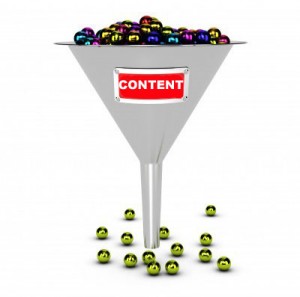You probably already know that content is the key to marketing businesses or services on the web these days. And I don’t need to tell you that new Google algorithms look for quality content – that is, content that’s informative and/or entertaining and generates engagement, discussion and link backs.
But wait, there’s more! Different kinds of quality content are more important in different stages of the buying cycle, so for the very best results you need to tailor the content that best accelerates the process at each stage of that buying cycle.
 The traditional sales funnel has changed from a linear path to more of a zigzag as customers tend to go back and forth between the stages in order to narrow down their possibilities. Still, there are three basic stages to the process some of which may be repeated during the buyer’s journey:
The traditional sales funnel has changed from a linear path to more of a zigzag as customers tend to go back and forth between the stages in order to narrow down their possibilities. Still, there are three basic stages to the process some of which may be repeated during the buyer’s journey:
• Research
• Interaction
• Decision
At each of these steps you have to ask yourself “What does my potential customer want or need at this particular stage in the process?”
The Research Stage
Here your potential customers are looking for a solution to a need. Say they want to start a new business: they have a need – a new business; you have a solution – a franchise. You need to attract them.
How do you do it?
a) Announce that you have the “World’s best, most profitable franchise in the whole wide world”
b) Hope they find you
c) Post an informative, well-written and entertaining blog post about “10 things to look for when considering a new business.”
Among the information: The benefits of a business franchise. Not a particular franchise, just franchising in general
The answer is c). It’s not about you; it’s about informative, useful, valuable content for your potential customer.
Announcing that you have the “World’s best, most profitable franchise in the whole wide world” is the kind of puffery that isn’t useful and gives no reason for people to do business with you. In fact, the more you boast about how wonderful you are, the less likely it is people will trust you.
And of course, if you choose b), you’ll get exactly what you put into the effort: nothing.
The kind of content that’s best at this stage:
• Infographics, entertaining videos, photos or engaging information – things the Content Marketing Institute says shows what you know, not what you sell.
• Social media – Facebook, Pinterest, Twitter, YouTube.
• Blogs.
The bottom line? Give something of value that draws people back for more.
The Interaction Stage
If you’ve crafted your message well, a percentage of the people you attracted in the research stage will come back to you to see if you have more to offer. And you do! The potential customer is looking for more information and you’re just the one to provide it. Remember: You’re still not selling your product; you are giving something of value to help with the buying decision.
An example of good, quality content at this point is a white paper, such as “What you should look for in a franchising opportunity.” Ask for the potential customer’s basic information – such as a name and email address – before giving the link to download the white paper. Now you can interact because you have a genuine contact to which you can send newsletters, reports or offerings such as webinars, ebooks and live events. The content will be geared to inform and address a potential customer’s specific problems and possible solutions.
Be careful not to inundate potential customers with so much content that you scare them off, but make sure not to be so laissez-faire that you lose any momentum you’ve built, or worse, make a potential customer feel as if you don’t care about them.
I know, easier said than done, right?
The Decision Stage
This is where the potential customer is making a purchase decision, so you want to provide more product-specific information about your product and what you have to offer to convert the prospect into a customer.
Content that’s best at this stage:
• Price sheets
• Comparisons to other products
• Case studies
• ROI calculators
• Demos
• Testimonials
The important thing at this stage is to show the potential customer what you do and why yours is the best product available. After that, simplify the buying process and provide information that shows that they are making the best decision possible.
And of course, I’m sure you already know that the work doesn’t end with the sale; be sure to follow up with updates, tips and other quality content that shows the customer that they have a relationship with you and that you care about keeping it.

